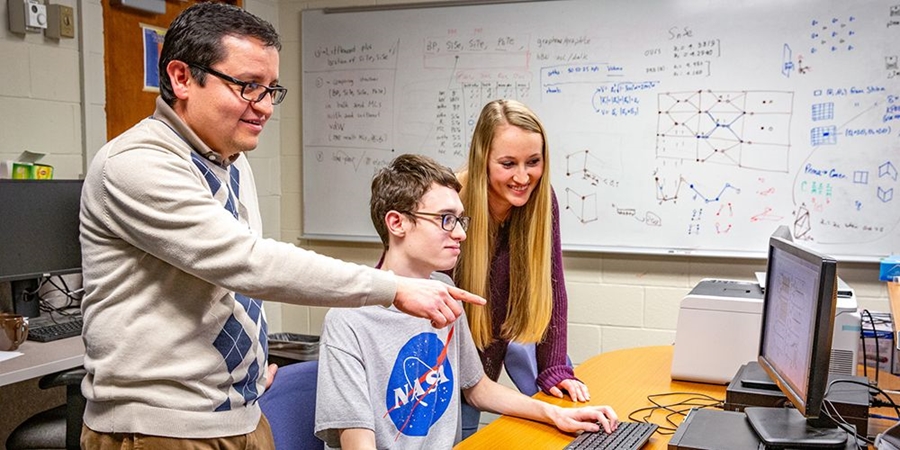
Many common materials exhibit new properties in two-dimensional, or monolayer, form, and the study of these materials can lead to insights into the tiny particles that make up matter, as well as the quantum rules that govern them. Salvador Barraza-Lopez, assistant professor of physics, is studying one such material, tin oxide. In his lab, Honors College students Tyler Bishop and Erin Farmer have honed their research skills and gained insight into future career possibilities as they uncover new information about this material. The two undergraduate students are first and second authors on a paper based on the research, which was published in Physical Review Letters.
"It's a problem that needs to be solved, and no one has solved it yet," said Farmer about the project. "That's an amazing way to spend your time."
While researchers have created forms of tin oxide with two layers, single layers of the material have yet to be obtained, so the researchers performed complicated calculations and used computer simulations to study how the material would behave in monolayer form at extremely low temperatures.
Tin oxide is made up of atoms arranged in rectangular shapes, like bricks in a wall. In most materials with a structure like this, the "bricks" are oriented either vertically or horizontally, with different sections, or domains, of the material exhibiting different orientations. For the units to shift from a vertical to a horizontal orientation, energy must be added to the system. The amount of energy required for this is specific to the material, and researchers refer to this amount as "J." This energy is thought of as a "barrier," which holds the units in place. According to the researcher's calculations, however, the value of J for a single layer of tin oxide is so low that the particles can "tunnel" through this barrier, as if they were to exist in both a vertical and a horizontal configuration at once, so that the units are not rectangles anymore but squares. This is called quantum paraelastic behavior.
Farmer contributed to the research by providing a model for the transition temperature of the material, which is the temperature at which the energy of the system equals J, allowing the material to shift from a rectangular to a square shape.
After Farmer performed this calculation, Bishop used a supercomputer based at the National Energy Research Scientific Computer Center in California to simulate the behavior of the material at very low temperatures. He was able to confirm Farmer's prediction of the transition temperature, but analyzing all the data from the simulations was a long process — months of staring at sequences of numbers. This task might have been too tedious for many students, but Bishop was able to keep focused by concentrating on the meaning behind the data.
"One thing that's difficult is that when you're just staring at all the numbers, you get lost and you forget what's happening," he explained. "So you have to constantly keep in mind, what am I actually doing rather than what am I typing; what does the structure look like; what are the atoms doing? I take one number at a time and imagine where it is."
"I think that's what makes a physicist and a scientist in general," Barraza-Lopez added. "That ability of going ahead of the number, to see what the number should be before you actually obtain it. Tyler is able to sustain focus for a long time because he's actually producing his own understanding of the numbers."
As the students learned more about tin oxide, they also gained valuable insights into the discipline of physics, the practice of research and their future career goals.
Bishop, who is an Honors College Fellow, is pursuing a double major in physics and math. He explored astrophysics early in his undergraduate career before settling on computational and theoretical physics. He plans to get a Ph.D. and become a physics professor. "I like how fundamental it is," he says of his chosen discipline. "All the other sciences are built off of physics."
Farmer, a Bodenhamer Fellow, is pursuing a triple major in physics, economics and math. She knows she wants to use her skills to help people around the world, but she's still figuring out whether to focus on development economics or humanitarian engineering.
"Erin has a very interesting view of the world, and her triple major reflects that," said Barraza-Lopez. "She sees herself as an interdisciplinary problem solver. She doesn't seem to be too concerned about disciplinary lines."
No matter where these students go when they complete their degrees, they will take with them the valuable experience of working in a lab, publishing their results and being the first to shed light on their own small part of the quantum world.
Additional authors were Afsana Sharmin, a master student in the Barraza-Lopez group, Alejandro Pacheco Sanjuan from Chile and Pierre Darancet from Argonne National Laboratory. This work was funded by the National Science Foundation (Grant No. DMR-1610126), the Department of Energy (Early Career Award DE-SC0016139, DE-AC02-06CH1135 and E-AC02-05CH11231), and FONDECIT, Chile (Project No. 117160).
Contacts
Camilla Shumaker, director of science and research communications
University Relations
479-575-7422, camillas@uark.edu